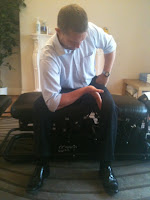Carpal Tunnel Syndrome (CTS) is one of the most common entrapment syndromes. Patients often complain of 'pins and needles' affecting the thumb, index, middle and half of the ring finger. CTS is noted most commonly in persons whose occupation or avocation requires substantial use of the hands. Patients may also complain of pain which may radiate up the arm to the shoulder. I will discuss the causes of CTS later on.
The Symptoms:
Patients complain of awakening from their sleep at night with 'pins and needles' affecting their fingers as mentioned above. Relief is most commonly brought on by simply "shaking their hand(s) out. The feeling of pins and needles dissipates and they can then return to sleep. Patients with severe cases may have to go through this routine several times a night.
The Cause(s):
CTS is caused by a compression of the "median nerve" at the wrist. The median nerve runs the length of the arm to the hand and distributes into the thumb, index, middle and half of the ring finger, starting at the neck/cervical spine. As a practicitoner, it is my job to investigate whether the pain in the hand is caused by an entrapment of this nerve in the carpal tunnel in the wrist or due to an impingement in the neck. Treatment would then be administered accordingly.
The most common causes or associations of CTS are:
-Idiopathic (arising from an unknown cause)
-Trauma to the wrist
-Fibrosis (the formation or development of excess fibrous connective tissue)
-Pregnancy
-Rheumatoid Arthritis
-Diabetes
-Hypothyroidism
The Treatment:
The treatment is determined by the severity of the symptoms. Being a chiropractor, I will always look to take a conservative approach first. If this is ever unsuccessful I would then refer the patient back to their GP for referral onto possible surgical intervention if deemed necessary.
Conservative treatment would consist mainly of the following:
-Carpal (wrist) manipulation/mobilisation - practitioner
-Cervical (neck), upper back, shoulder and elbow manipulation/mobilisation - practitioner
-Soft Tissue (muscle) release - practitioner
-PIR stretches for the forearm - practitioner
-Tendon gliding exercises - patient
-Median nerve mobilisation - patient
-Passive self stretching - patient (see pictures)
-Cock-up slints
All 'homework' given to the patient will be fully explained during the treatment session.

Passive self stretching of the forearm muscles of the wrist can be done numerous times a day. Placing the forearm between the thighs (picture 1) allows control of the stretch and frees the other hand to stretch the thumb (picture 2). Slowly squeezing the thighs together increases the stretch of the fascia overlying the carpal tunnel. Each stretch should be held for 30 seconds.
.JPG) Well I hope that has given you a bit more of an insight into what CTS is all about and what can actually be done to relieve any symptoms. Should you have any questions on this subject please do not hesitate to get in contact and I would be very happy to discuss this in person. Come if for a 15 minute consult for only £5.
Well I hope that has given you a bit more of an insight into what CTS is all about and what can actually be done to relieve any symptoms. Should you have any questions on this subject please do not hesitate to get in contact and I would be very happy to discuss this in person. Come if for a 15 minute consult for only £5.






